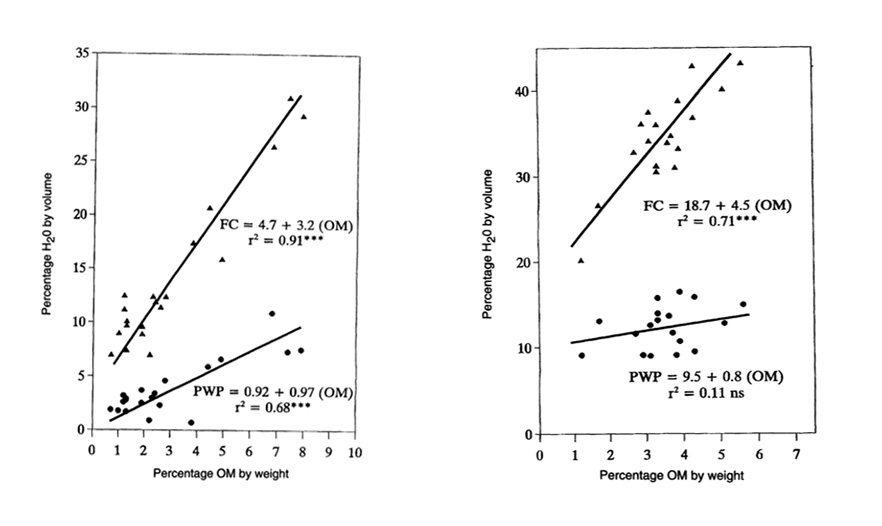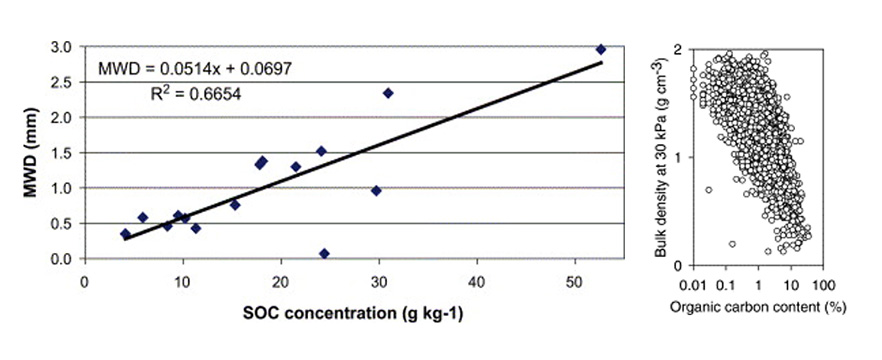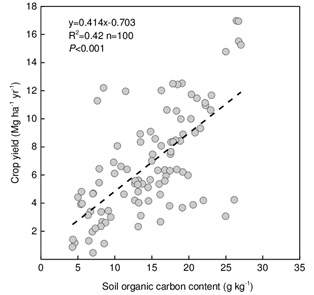What is soil organic carbon?
Soil organic carbon (SOC) is the carbon component of soil organic matter (SOM), excluding inorganic carbon forms like carbonates. It is derived from decomposing plant and animal residues, root exudates, and microbial biomass (Lehmann & Kleber, 2015). Soil organic carbon generally makes up about 58% of SOM and is a vital indicator of soil fertility, biological activity, and nutrient cycling. Soil organic carbon is quantified using methods such as dry combustion (e.g., LECO analyzer for loss on ignition) or wet oxidation (e.g., Walkley-Black). For calcareous soil, SOC = Total C – Inorganic C, such as carbonates (Soil Health Institute). The University of Missouri Soil Health Assessment Center measures SOC using a LECO Analyzer for loss on ignition.
What is soil organic matter?
Soil organic matter refers to the organic component of soil, consisting of plant and animal residues at various stages of decomposition, cells and tissues of soil organisms, and substances synthesized by soil organisms. It plays a critical role in maintaining soil structure, fertility, and biological activity. Soil organic matter improves water retention, cation exchange capacity, and serves as a reservoir for essential nutrients such as nitrogen, phosphorus, and sulfur (Weil & Brady, 2017). It also contributes to carbon sequestration (Lal, 2004). Overall, SOM is a fundamental indicator of soil health, productivity, and agricultural sustainability.
Soil organic matter is commonly divided into particulate organic matter, dissolved organic matter, and stabilized humus-like compounds that interact with soil minerals (Six et al., 2002). The decomposition and transformation of SOM is driven by microbial activity and influenced by factors such as temperature, moisture, soil texture, and land management practices (Lehmann & Kleber, 2015).
Soil organic matter is commonly estimated by measuring SOC in the laboratory and multiplying it by a standard conversion factor of 1.724, based on the assumption that SOM contains around 58% carbon. However, this carbon fraction can vary with soil type and SOM composition (Nelson & Sommers, 1982; Pribyl, 2010). The typical conversion of SOM to SOC is:
Why does soil organic carbon matter?
Soil organic carbon is a vital driver of the biological, chemical, and physical processes that are important for soil health and productivity (Franzluebbers, 2002; Lal, 2006a; Clara et al., 2017). It influences key soil functions such as nutrient cycling, aggregate formation, water retention, and microbial activity, all of which are related to crop performance and resilient cropping systems.
Soil organic carbon acts as a unifying metric for evaluating changes in soil health over time. It responds to soil management practices and environmental conditions, making it a reliable and interpretable soil health indicator (Culman et al., 2012). More specifically, it serves a crucial role in regulating nitrogen, phosphorus, and sulfur dynamics through mineralization and microbial turnover (Drinkwater & Snapp, 2007). The importance of SOC extends beyond soil fertility. It enhances soil structure, porosity, infiltration, and drought tolerance, especially in degraded or coarse-textured soils (Hudson, 1994; Rawls et al., 2003; Lal, 2006a). Management factors that increase SOC are residue retention, addition of organic nutrients, cover crops, and reduced tillage (Liptzin et al., 2022).
Soil organic carbon influences key soil functions
- Water retention and infiltration: Soil organic carbon significantly improves the soil’s water-holding capacity, especially in coarse-textured soils. This enhances drought resilience and crop water use efficiency (Hudson, 1994; Rawls et al., 2003; Bagnall et al., 2022; Figure 1). A 1% increase in SOC can raise available water capacity by 1.5-2.5 mm per 12 inches (30 cm) soil depth (Hudson, 1994; Minasny et al., 2017).

- Aggregate stability and soil structure: Soil organic carbon enhances soil physical properties by binding soil particles into stable aggregates. This aggregation improves soil structure, increases porosity, enhances water infiltration, and reduces both erosion and compaction risks (Tisdall & Oades, 1982; Six et al., 2002; Subbian et al., 2000; Bronick & Lal, 2005; Figure 2).

- Cation Exchange Capacity (CEC): Soil organic carbon contributes to the soil’s capacity to retain nutrients due to negative charges on organic matter surfaces. Soils high in organic carbon tend to have greater nutrient-holding capacity, especially in sandy or low-clay soils where mineral contributions to CEC are limited (Schjønning et al., 2004).
- Nutrient cycling: Soil organic carbon is a reservoir of nitrogen, phosphorus, and sulfur, which supports microbial processes that convert these nutrients into plant-available forms (Drinkwater & Snapp, 2007). Soil organic carbon helps supply and buffer nutrients through mineralization and sorption (Kallenbach et al., 2016). This process occurs through the microbial decomposition of organic matter.
- Potentially Mineralizable Nitrogen (PMN): Soil organic carbon provides the energy source for soil microorganisms that mediate the nitrogen mineralization process. Potentially mineralizable nitrogen (PMN) is largely derived from the labile fraction of SOC, which includes fresh residue, microbial biomass, and easily decomposable SOM (Stanford & Smith, 1972). Higher SOC typically supports a larger and more active microbial community, which in turn increases the potential for N mineralization and supply of N for plants (Paul, 2016). Soils with greater SOC tend to have greater microbial biomass nitrogen, which also correlates strongly with PMN (Weil & Brady, 2017; Figure 3). The conversion of PMN to an inorganic form of N is affected by aeration, temperature, and moisture.

- Microbial activity: Microbial activity, often assessed through soil respiration or microbial biomass carbon, is closely tied to SOC. The primary energy source for soil microbes is SOC. Soil organic carbon supports diverse microbial communities that drive nutrient cycling and serve critical roles in plant health and disease suppression (Schloter et al., 2018). The labile fraction of SOC, which is readily available for microbial use, reflects active microbial populations and responds rapidly to management practices. This makes it a sensitive indicator of biological soil health. Higher SOC levels have been linked to greater microbial diversity and enhanced ecosystem functioning (Lehmann & Kleber, 2015).

- Crop growth/yield: The positive relationship between SOC and crop performance is well-documented. Soil organic carbon enhances nutrient and water availability, which directly improves root growth and yield stability in low-input and drought-prone cropping systems (Lal, 2006b; Oldfield et al., 2020). Lal (2006a) reported that for each additional 892 lb of SOC per acre, annual yield increased approximately 1.8-5.4 bu ac-1 yr-1 for corn, 0.3-0.7 bu ac-1 yr-1 for soybean, 0.7-2.6 bu ac-1 yr-1 for wheat, and 0.6-2.7 bu ac-1 yr-1 for rice. Han et al. (2018) reported that a 0.1% increase in SOC could lead to a crop yield increase of approximately 4.0 to 6.6 bu ac-1 yr-1, depending on the crop and growing conditions (Figure 4). In a corn-soybean rotation, higher SOC levels improved nitrogen use efficiency and yield consistency (Franzluebbers, 2010). These benefits are especially important as producers seek resilient and economically viable systems amid climate variability and rising input costs.
Recommended sampling depth for soil organic carbon testing
The standard depth for sampling soil organic carbon is the top 0-6 inches (Soil Health Institute, 2023; USDA-NRCS, 2025). This depth captures the surface soil layer most influenced by tillage, organic matter additions, root activity, and other management practices. This layer of soil is the most sensitive to changes in active carbon pools, to detect shifts in soil health due to conservation or fertilizer management systems (Culman et al., 2012).
Interpreting soil organic carbon
Soil organic carbon is commonly expressed as a percentage of soil weight (%) or as mass per acre (lb C ac-1). Interpretation of SOC levels helps assess soil condition and management impact. While values can vary by region, soil type, and climate, the following general guidelines were developed for surface soils (0-6 inches).
Table 1. Soil Health Benchmarks
| Soil Health Category | SOC (%) | Soil Health Status/Implication | MO Soil* Percentile |
|---|---|---|---|
| 1. Very Low | < 0.75 | Severely depleted soil organic matter; limited nutrient retention, microbial life, and structure. High risk of erosion and compaction. Requires major restoration | 0-5 |
| 2. Low | 0.75 – 1.5 | Reduced biological and physical functioning; suboptimal productivity. Indicates recent degradation or low input history. | 6-25 |
| 3. Medium | 1.6 – 2.5 | Adequate carbon level for moderate productivity. Needs improvement for long-term sustainability. | 26-80 |
| 4. High | 2.6 – 3.5 | Well-structured, fertile, and biologically active soil. Supports resilient cropping systems. | 81-95 |
| 5. Very High | > 3.5 | Exceptional soil quality; may support ecosystem services beyond crop production (e.g., carbon sequestration); high microbial and nutrient potential. | 96-100 |
| * Based on >13,000 SOC data across different soil textures in Missouri (Data source: Cover Crop Cost-Share Program from 2015 to 2023, Soil Health Assessment Center, University of Missouri, Columbia, MO). | |||
These soil health category benchmarks may shift depending on local soil characteristics. For example, sandy soils naturally contain less organic carbon than clay or silty soils due to lower organic matter stabilization capacity (Weil & Brady, 2017: Figure 5); therefore, additional inputs and management is needed.
Typical Total Organic Carbon (%) range across soil types in Missouri (10th to 90th percentiles):
Sandy soils: 0.4 – 1.7 (sand, loamy sand, sandy loam).
Loamy soils:1.3 – 2.7 (loam, silt, silt loam, sandy clay loam, clay loam).
Clayey soils: 1.5 – 3.3 (clay, silty clay, sandy clay, silty clay loam).

Improving soil organic carbon: Management strategies and benefits
Increasing SOC is vital for improving soil health, fertility, and production resilience. Soil organic carbon can be built and maintained through a combination of conservation practices that reduce carbon losses and enhance inputs. The following strategies are widely recognized in scientific literature for their effectiveness in increasing SOC levels:
- Cover cropping: Planting cover crops during fallow periods enhances carbon inputs by contributing additional root and shoot biomass, while also reducing soil erosion, compaction, and increasing water infiltration. In an annual cropping system, grasses are particularly effective at sequestering carbon due to their high biomass production (Poeplau & Don, 2015). Cover crops also improve soil microbial activity, which aids organic matter decomposition and humus formation.
- Reduced or no tillage: Conventional tillage accelerates the breakdown of organic matter and increases carbon loss through oxidation. Conservation tillage and no-till systems reduce soil disturbance, preserve soil structure, minimize erosion, and allow SOC to accumulate in surface layers (West & Post, 2002; Lal et al., 2007).
- Organic amendments: Applying manure, compost, or biochar adds stable forms of carbon to the soil and supports microbial diversity. Biochar, in particular, has been shown to persist in soils for centuries. It can enhance carbon sequestration while improving nutrient retention and pH balance (Glaser et al., 2002; Lehmann et al., 2011).
- Diversified crop rotations: Including a variety of crops in rotation increases the diversity and quantity of organic inputs to the soil, supporting a broader microbial community and improving nutrient cycling efficiency (McDaniel et al., 2014). Perennial crops and deep-rooted species are especially effective at contributing belowground carbon. Other research indicates SOC was affected by increased rotational diversity when annual crops were grown (Liptzin et al., 2022)
- Perennial crops and grazing systems: Grazing livestock on cover crops or perennial pastures helps incorporate organic matter into the soil through manure deposition and root turnover. Properly managed grazing systems have been shown to improve SOC over time in pastures (Franzluebbers & Stuedemann, 2008).
These practices can enhance SOC levels, improve soil structure and water retention, reduce input costs, and encourage long-term productivity. These strategies can sequester atmospheric carbon dioxide in soils.
Conclusions
Soil organic carbon is an indicator of the soil’s capacity to sustain crop production and ecological functions. Regular monitoring and targeted management of SOC can enhance farm profitability, increase resilience to stress, and promote long-term sustainability. For producers and agronomists alike, understanding and optimizing SOC should be central to soil health strategies.
References
Bagnall, D. K., Morgan, C. L.S., Cope, M., Bean, G. M., Cappellazzi, S., Greub, K., Liptzin, D., Norris, C. L., Rieke, E., Tracy, P., Aberle, E., Ashworth, A., Bañuelos Tavarez, O., Bary, A., Baumhardt, R. L., Borbón Gracia, A., Brainard, D., Brennan, J., Briones Reyes, D., . . . Honeycutt, C. W. (2022). Carbon-sensitive pedotransfer functions for plant available water. Soil Science Society of America Journal, 86, 612–629.
Bhogal, A., Chamberlain, P., Whitmore, A. P., Powlson, D. S., & Coleman, K. (2009). The effects of reduced tillage practices and organic material additions on the carbon content of arable soils. Scientific Report to the Department for Environment, Food and Rural Affairs (Defra), Project SP0561.
Bronick, C. J., & Lal, R. (2005). Soil structure and management: A review. Geoderma, 124(1–2), 3–22.
Clara, L., Fatma, R., Viridiana, A., & Liesl, W. (2017). Soil organic carbon: the hidden potential. Rome: Food and Agriculture Organization of the United Nations.
Culman, S. W., Snapp, S. S., Freeman, M. A., Schipanski, M. E., Beniston, J., Lal, R., ... & Wander, M. M. (2012). Permanganate oxidizable carbon reflects a processed soil fraction that is sensitive to management. Soil Science Society of America Journal, 76(2), 494–504.
Drinkwater, L. E., & Snapp, S. S. (2007). Nutrients in agroecosystems: Rethinking the management paradigm. Advances in Agronomy, 92, 163–186.
Franzluebbers, A. J. (2002). Soil organic matter stratification ratio as an indicator of soil quality. Soil and Tillage Research, 66(2), 95–106.
Franzluebbers, A. J. (2010). Achieving soil organic carbon sequestration with conservation agricultural systems in the southeastern United States. Soil Science Society of America Journal, 74(2), 347–357.
Franzluebbers, A. J., & Stuedemann, J. A. (2008). Soil-profile organic carbon and total nitrogen during 12 years of pasture management in the Southern Piedmont USA. Agriculture, Ecosystems & Environment, 129(1–3), 28–36.
Glaser, B., Lehmann, J., & Zech, W. (2002). Ameliorating physical and chemical properties of highly weathered soils in the tropics with charcoal – a review. Biology and Fertility of Soils, 35(4), 219–230.
Han, X., Xu, C., Dungait, J. A., Bol, R., Wang, X., Wu, W., & Meng, F. (2018). Straw incorporation increases crop yield and soil organic carbon sequestration but varies under different natural conditions and farming practices in China: a system analysis. Biogeosciences, 15(7), 1933-1946.
Hudson, B. D. (1994). Soil organic matter and available water capacity. Journal of Soil and Water Conservation, 49(2), 189–194.
Kallenbach, C. M., Grandy, A. S., Frey, S. D., & Diefendorf, A. F. (2015). Microbial physiology and necromass regulate agricultural soil carbon accumulation. Soil Biology and Biochemistry, 91, 279-290.
Lal, R. (2004). Soil carbon sequestration to mitigate climate change. Geoderma, 123(1-2), 1-22.
Lal, R. (2006a). Enhancing crop yields in the developing countries through restoration of the soil organic carbon pool in agricultural lands. Land Degradation & Development, 17(2), 197–209.
Lal, R. (2006b). Managing soils for feeding a global population of 10 billion. Journal of the Science of Food and Agriculture, 86(15), 2273–2284.
Lal, R., Follett, R. F., Stewart, B. A., & Kimble, J. M. (2007). Soil carbon sequestration to mitigate climate change and advance food security. Soil Science, 172(12), 943–956.
Lehmann, J., & Kleber, M. (2015). The contentious nature of soil organic matter. Nature, 528(7580), 60–68.
Lehmann, J., Gaunt, J., & Rondon, M. (2011). Bio-char sequestration in terrestrial ecosystems – A review. Mitigation and Adaptation Strategies for Global Change, 11(2), 403–427.
Liptzin, D., Norris, C. E., Cappellazzi, S. B., Bean, G. M., Cope, M., Greub, K. L. H., … Honeycutt, C. W. (2022). An evaluation of carbon indicators of soil health in long term agricultural experiments. Soil Biology and Biochemistry. Advance online publication.
McDaniel, M. D., Tiemann, L. K., & Grandy, A. S. (2014). Does agricultural crop diversity enhance soil microbial biomass and organic matter dynamics? A meta‐analysis. Ecological Applications, 24(3), 560–570.
Minasny, B., Malone, B. P., McBratney, A. B., Angers, D. A., Arrouays, D., Chambers, A., ... & Winowiecki, L. (2017). Soil carbon 4 per mille. Geoderma, 292, 59–86.
Nelson, D. W., & Sommers, L. E. (1982). Total carbon, organic carbon, and organic matter. Methods of soil analysis: Part 2 chemical and microbiological properties, 9, 539-579. ASA and SSSA.
Oldfield, E. E., Bradford, M. A., & Wood, S. A. (2020). Global meta-analysis of the relationship between soil organic matter and crop yields. Soil, 6(1), 15-32.
Paul, E. A. (2016). Soil microbiology, ecology and biochemistry (4th ed.). Academic Press.
Poeplau, C., & Don, A. (2015). Carbon sequestration in agricultural soils via cultivation of cover crops – A meta‐analysis. Agriculture, Ecosystems & Environment, 200, 33–41.
Pribyl, D. W. (2010). A critical review of the conventional SOC to SOM conversion factor. Geoderma, 156(3–4), 75–83.
Rawls, W. J., Pachepsky, Y. A., Ritchie, J. C., Sobecki, T. M., & Bloodworth, H. (2003). Effect of soil organic carbon on soil water retention. Geoderma, 116(1–2), 61–76.
Schjønning, P., Elmholt, S., & Christensen, B. T. (2004). Managing soil quality: challenges in modern agriculture (pp. viii+-344). CABI Publishing.
Schloter, M., Nannipieri, P., Sørensen, S. J., & van Elsas, J. D. (2018). Microbial indicators for soil quality. Biology and Fertility of Soils, 54(1), 1-10.
Six, J., Conant, R. T., Paul, E. A., & Paustian, K. (2002). Stabilization mechanisms of soil organic matter: Implications for C-saturation of soils. Plant and Soil, 241(2), 155–176.
Soil Health Institute (SHI). (2023). Soil health measurement framework for U.S. agriculture. Soil Health Institute.
Stanford, G., & Smith, S. J. (1972). Nitrogen mineralization potentials of soils. Soil Science Society of America Journal, 36(3), 465–472.
Subbian, P., Lal, R., & Akala, V. (2000). Long-term effects of cropping systems and fertilizers on soil physical properties. Journal of Sustainable Agriculture, 16(2), 89-100.
Tisdall, J. M., & Oades, J. M. (1982). Organic matter and water-stable aggregates in soils. Journal of Soil Science, 33(2), 141–163.
USDA-NRCS (Natural Resources Conservation Service). (2025). Soil Health Testing to Support Conservation Planning (Technical Note No. 470-16). U.S. Department of Agriculture.
Weil, R., & Brady, N. C. (2017). The Nature and Properties of Soils (15th ed.). Pearson Education.
West, T. O., & Post, W. M. (2002). Soil organic carbon sequestration rates by tillage and crop rotation. Soil Science Society of America Journal, 66(6), 1930-1946.